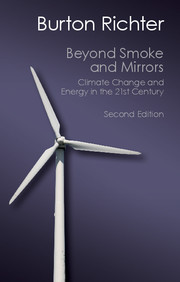Book contents
- Frontmatter
- Contents
- Preface to the Second Edition
- List of Units
- List of Conversion Factors
- List of Abbreviations
- 1 Introduction
- Part I Climate
- Part II Energy
- 6 Taking up Arms Against this Sea of Troubles
- 7 How Fast to Move: A Physicist’s Look at the Economists
- 8 Energy, Emissions, and Action
- 9 Fossil Fuels – How Much Is There?
- 10 Electricity, Emissions, and Pricing Carbon
- 11 Efficiency: the First Priority
- 12 Nuclear Energy
- 13 Renewables
- 14 Biofuels: Is There Anything There?
- 15 An Energy Summary
- Part III Policy
- References
- Index
14 - Biofuels: Is There Anything There?
Published online by Cambridge University Press: 05 November 2014
- Frontmatter
- Contents
- Preface to the Second Edition
- List of Units
- List of Conversion Factors
- List of Abbreviations
- 1 Introduction
- Part I Climate
- Part II Energy
- 6 Taking up Arms Against this Sea of Troubles
- 7 How Fast to Move: A Physicist’s Look at the Economists
- 8 Energy, Emissions, and Action
- 9 Fossil Fuels – How Much Is There?
- 10 Electricity, Emissions, and Pricing Carbon
- 11 Efficiency: the First Priority
- 12 Nuclear Energy
- 13 Renewables
- 14 Biofuels: Is There Anything There?
- 15 An Energy Summary
- Part III Policy
- References
- Index
Summary
Introduction
My first introduction to the idea of biofuels came when I met the Nobel Laureate chemist, Melvin Calvin, in the late 1970s (his prize was awarded in 1961 for the discovery of how photosynthesis worked). It was the time of the Arab oil embargo and he had a dream of what he called growing oil. He had found a plant in the Amazon that produced oil that could directly substitute for diesel fuel, and was working on improving the output of a different plant that could grow in the temperate zone, and on poor ground. He wanted, through genetic engineering, to greatly increase its natural production of an oil-like substance. He did not think using food crops for energy systems was a good idea because of population growth. We would need all the food we could get. Mel retired in 1980 (continuing to work as do most of us) and died before he succeeded. The science community is still trying to bring Mel Calvin’s vision to life.
Today, in the United States biofuels means ethanol from corn, while in Brazil it is ethanol from sugarcane (the European Union has an ethanol program too, and I will come back to it). After looking in some detail at the US program, I confess that I have become a biofuels skeptic. Most of what one hears about corn as a source of fuel ethanol that saves energy and reduces greenhouse gas emissions is propaganda from agribusiness (I think Calvin would agree). Sugarcane is one crop that does give the promised benefits, but even its long-term contribution to reducing greenhouse gas emissions depends on how land is used. There is an intensive worldwide research program aimed at developing much more effective biological sources of fuel, but as of the writing of the first edition it had not yet reached practicality. Now, five years later, it still has not reached practicality.
- Type
- Chapter
- Information
- Beyond Smoke and MirrorsClimate Change and Energy in the 21st Century, pp. 272 - 290Publisher: Cambridge University PressPrint publication year: 2014



